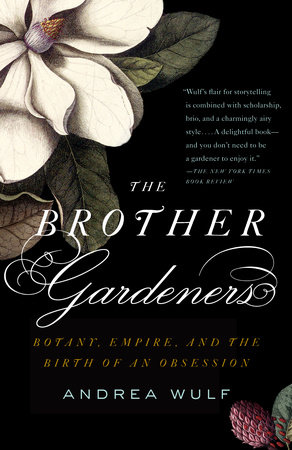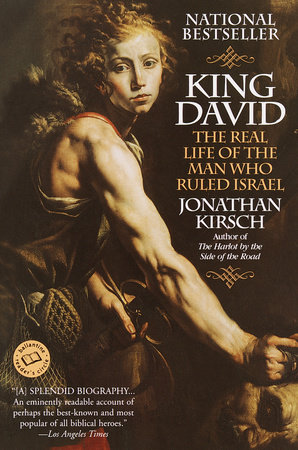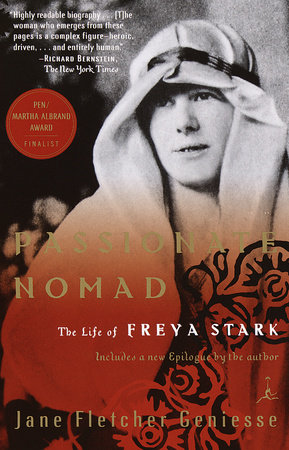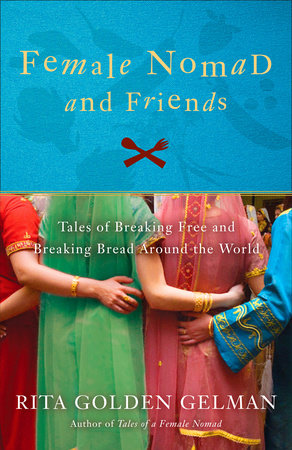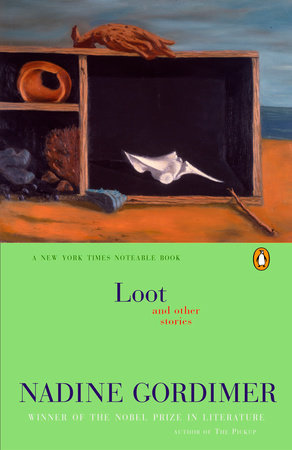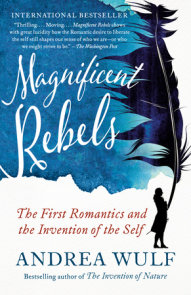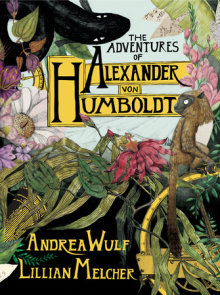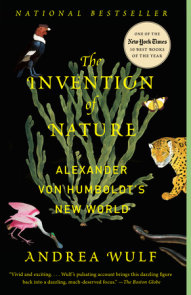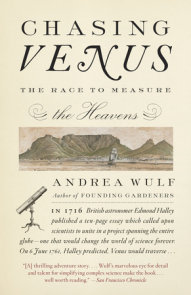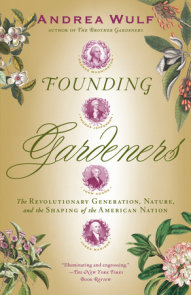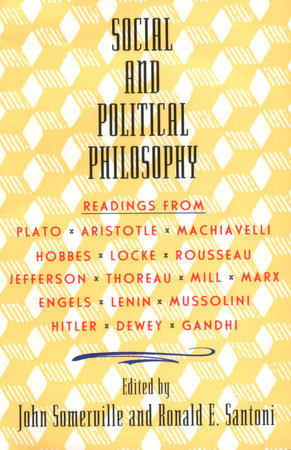Author Q&A
Q: THE BROTHER GARDENERS is a group biography of the founding brothers of the modern garden. It is a story of an extraordinary group of men who are all completely absorbed with botany, plant collection and gardens. It is a tale of adventure, competition and commerce as well as science, reason and obsession. What is your favorite tale from your biography?
A: There are too many fabulous tales to really make this decision but there is one little episode which I have always loved because it brings together the obsession and adventure that runs through so many of these stories.
In summer 1768 Joseph Banks – dashingly handsome and one of the wealthiest landowners in Britain – joined Captain Cook on the Endeavour for the most daring voyage the British had ever planned. Together they would circumnavigate the world. Three months after they set sail they reached Rio de Janeiro and Banks couldn’t wait to explore the local flora, but the Portuguese governor of the colony thought them to be spies and refused any botanical excursions. Imagine this, stuck on the Endeavour, Banks peers through his telescope and sees the flora and fauna of South America laid out like seductive wares in an exotic bazaar. There were humming birds hovering over clambering bougainvilleas which were dripping with pink blossoms, as well as hedges of brightly colored flowers and juicy fruits dangling from trees. So close and still so far away. In his frustration, Banks writes a letter to a friend which, I think, sums up how the Brother Gardeners felt about plants: ‘I feel like a French man laying swaddled in linnen between two of his Mistresses, both naked [and] using every possible means to excite desire’.
But if you ask me who my favorite character is, I have a clear answer (although I should probably like all my characters equally) – I just adore John Bartram, the American farmer who changed the English parkland and made his countrymen love American native species. Working through his hundreds of letters, I encountered a brave and diligent man who was alive with intellectual curiosity. He brought a smile to my face when he described how he would scramble up pine trees and hold his hat out to catch the seeds which he shook from their hanging cones. I adore him for his habit of falling out of trees, and for the melancholy which overcame him when he failed to find the seeds he sought. He was also a man so distractedly obsessed that he would often lose his way, or would find himself stranded in storms and darkness because he failed to notice sudden changes of weather when searching for a particular plant. He was strong-minded, loyal and passionate – I would have loved if I were able to walk with him through his garden.
Q: THE BROTHER GARDENERS is a thoroughly researched, rich and entertaining narrative on the history of the British obsession with gardens and plants. What was your research process like? What primary sources were you able to tap in to? How were you able to string all of the stories together so beautifully?
A: As a historian the most exciting thing that can happen is when you find hundreds and hundreds of letters that invite you into a new world. The letters between the Brother Gardeners ushered me into a world adventure, passion and competition. Because they were all part of an international network rather than all being, say in London, they didn’t meet in person but wrote to each other, hence the many letters. There are hundreds of letters, for example, between the American John Bartram and British Peter Collinson which are just wonderful. They are peppered with scientific observations, evocative descriptions of Bartram’s plant hunting trips in the American wilderness and pure boasting about their horticultural triumphs. They sometimes bickered like a squabbling old couple and these petty arguments could last a year or longer depending on the postal delays between London and Philadelphia. And there are hundreds and hundreds of other letters that crisscrossed the oceans to correspondents across the globe because the Brother Gardeners wanted the whole world in their gardens. And because they all knew each other, these letters are almost like a web that links the wider scientific developments with human stories.
Another fun part of the research was following Bartram’s footsteps (equipped with his letters) through the Appalachians, the Shenandoah Mountains and the Catskills. More tedious in terms of research but equally rich in outcome was my research into the plants themselves. Over two years I build up an enormous plant database that would allow me to identify plants (difficult because of constantly changing plant names and their introduction dates) all based on a comparison of Philip Miller’s eight editions of the Gardeners Dictionary and dozens of nursery catalogues. The nucleus of this plant database is now the ‘Glossary’ at the end of the book.
Q: Your story tells of the British obsession with gardening that flourished during the eighteenth century. What was happening in the garden before your story begins?
A: Some of the Brother Gardeners created the most innovative gardens in England when they dismantled the ideas that had underpinned previous garden designs. They eschewed the formal arrangements in which each specimen plant had stood alone against a backdrop of ebony earth, like the elegant marquetry work on a precious piece of furniture of the time. In the seventeenth-century garden, no branch or flower-head had been allowed to grow unruly. These gardens had been like precious jewel boxes in which each gem was laid out side by side in order to be inspected and admired. In the new gardens, however, it was nature herself who created the shapes and patterns. Until Bartram’s seed boxes arrived in Britain there was little color in the garden for at least five months of the year, but the American species brought for the first time fiery autumn foliage to the English parkland and the many American evergreens created winter gardens. Where before intricate patterns cut in turf had brought variety to the pleasure ground now glorious shrubberies – scented and colorful – adorned the garden. The Brother Gardeners were using trees and shrubs like ‘living pencils’. These were gardens in which Enlightenment thinking found its visual expression. For centuries, high walls had excluded untamed nature from the garden, providing protection from the landscape beyond. Now, with the Enlightenment and man’s growing knowledge of the natural world, gardeners embraced the idea of letting nature reign.
Q: Myth and superstition had reigned in English gardens for centuries. How did these men, The Brother Gardeners, cast aside these ideas?
A: For centuries garden books, for example, had repeated the flawed advice from ancient Greek and Roman horticultural treatises. They advised to sow seeds during full moon in order to grow flowers with double blossom, that lemons could be turned red by grafting them on to pomegranate, or that apples could be made sweeter by watering the tree with urine. The Brother Gardeners turned against this by making experiments and observations. Instead of repeating plant lore, they applied new rigorous scientific principals to gardening and botany.
Philip Miller, for example, the head gardener of the Chelsea Physic Garden, published a book called the Gardeners Dictionary in 1731 that would change gardening forever – in fact, I think it is the most important horticultural publication of the eighteenth century. Gardeners Dictionary was the first systematic and comprehensive manual for practical gardening, entirely based on Miller’s own observations. It was a complete catalogue of all plants that were in cultivation in Britain as well as details on their cultivation and propagation. For the first time professional knowledge was available for amateur gardeners. Its concept was so insightful that it became an instant success, influencing every gardening book that followed it. Indeed, Miller’s Dictionary laid the foundation for much of our modern horticultural knowledge, and provided a template on which all plant encyclopedias are based today.
Q: One of the most important relationships in the book (and in the history of horticultural trade) is that of the Brit, Peter Collinson and the American, John Bartram. They created a lucrative trade in living plants and seeds. What role did they each play in the trade between the US and the UK? And what effect did they have on garden design
A: The relationship between the cloth merchant Peter Collinson and the American farmer John Bartram is one of the reasons why I wanted to write this book. It’s the most important horticultural friendship in the eighteenth century because together they transformed the English garden. The story begins in January 1734 when Collinson receives a box of seeds and cuttings that Bartram sent from Philadelphia – the first of many hundreds that would cross the ocean over the next decades.
Together they introduced more than 200 new species to Britain, but their greatest achievement was the scale of the plant enterprise – the sheer quantities of seeds. By the end of the eighteenth century plants that had only been grown as choice rarities in a few botanic collections at the beginning of the century had become so common that they were available cheaply in nurseries from London to Yorkshire.
But there was much more to the relationship between Collinson and Bartram than the trade in seeds and plants. Over almost four decades they became the closest friends although they never met. They shared their passion for plants, consoled each other when death or illness struck their families, teased each other and gossiped about mutual friends – ‘Our good frd B Franklin grows fat & Jolly’, Collinson wrote to Bartram. Their letters are windows into their souls, intimate, funny and passionate. At the same time their relationship also mirrors the changes between Britain and America as the colonies moved towards independence. As the colonies changed from subservience to independence so Bartram changed from deferential farmer to international respected botanist.
Q: One of the Brother Gardeners, Swedish botanist Carl Linnaeus, was a cantankerous man but he was also a genius botanist who pioneered a revolutionary system of plant classification and naming system. What was Linnaeus’ system and why was it an important discovery, particularly in this time period? What sort of system was used previously?
A: Linnaeus professed himself unable to ‘understand anything that is not systematically ordered’ and invented in the 1730s an entirely new way of classifying plants using a system based on their reproductive organs. He divided plants into 24 classes according to the number of their male organs, the stamens – which he called ‘husbands’. These classes were then further distinguished by the number of the female organs – the ‘wives’, or pistils. In this so-called ‘sexual system’, plants made love in the flower head or ‘bridal bed’ as Linnaeus called it.
Until then the classification of plants had been complex and very laborious. It took years of practice to learn, required expert tuition and access to collections of dried specimens and to expensive, hand-colored botanical books. Linnaeus’s so-called ‘sexual system’, however, was so simple and easy that everybody who could count could learn it. At a time of imperial expansion, when the discovery of new worlds revealed thousands of new species, the sexual system was invaluable because it could be used everywhere, in the wilderness of the colonies or in the libraries of learned societies in London. Botanists, though, thought it ‘too smutty for British ears’ and the Vatican added Linnaeus’ books to its ‘forbidden’ list.
Linnaeus also came up with a new naming system of plants which is used to this day: the binominal nomenclature. Linnaeus gave every plant a universal two-word name, Magnolia grandiflora, for example, a name that is the same in London, Philadelphia or Sydney. Without these standardized names there would be chaos and confusion. He was also able to confer a certain immortality on fellow botanists by naming plants in their honor. For his old teacher Olof Rudbeck, for example, Linnaeus chose the glorious Rudbeckia. But he also used it against his enemies – he named for example a stinking weed Siegesbeckia after Johann Siegesbeck, a man who had condemned the sexual system as ‘loathsome harlotry’.
Q: As the nineteenth century dawned, the possession of a garden came to be seen as an essential pre-requisite for happiness. In what ways did these men change the face of horticulture, for the better?
A:Without the achievements of The Brother Gardeners, England would not have become such a nation of gardeners. Today our flowerbeds are crowded with the suburban descendants of plants brought to Britain from North America, South Africa, Australia and the Far East. They are the offspring of Bartram’s carefully packed seeds. Even England’s rolling parkland – the embodiment of the ‘green and pleasant land’ – is made up of foreign introductions. Without these, we would be deprived of the spectacular effect of glossy evergreens, dazzling autumn foliage and colorful blossom. From Bartram to Banks, the Brother Gardeners left a lasting legacy. The garden revolution of the eighteenth century is still alive in the English landscape, and ingrained in the nation’s psyche today.
Q: When you left your hometown of Hamburg, Germany for London, you were amazed to find a nation obsessed with gardening. You were now living in a nation fanatical about something you knew little about. Where did your interest in this world, and in this story in particular, begin?
A: When I came to Britain in the mid-nineties I couldn’t quite believe how obsessed everybody was with gardening. Everybody, young and old seemed to think that a day digging in the flowerbeds was great entertainment. I can’t count how many evenings I have spent listening to people talk about their allotments and flowerbeds, and their horticultural failures and successes. Before long, I had my own garden – a tiny patch of green at the back of a typical London terrace. But I could not tell one plant from another. My horticultural journey began with an excursion to a bookshop and the purchase of a glossy plant dictionary. Identifying my plants proved to be more complicated than I had anticipated and I took to sending startled visitors into the garden in case they could help. Soon I learnt what plants where in my garden and began to look after them. I learnt how to divide delphiniums and how to take cuttings from my dahlia tubers. Whenever I worked in a library, I would use my lunch breaks to search out plant books.
One day I opened a volume that fundamentally changed the way I looked at my plants. This was Miller’s Gardeners Dictionary. What most surprised me was how much of what I had learned about gardening during the previous months had been developed during the eighteenth century, and how many of my plants had been introduced into Britain at that time. As I delved further, it became clear that Miller was part of a much larger plant-collecting and botanical network that stretched to every known corner of the globe. When I then discovered the correspondence between Peter Collinson and John Bartram a picture began to emerge of a horticultural and botanical revolution which had laid the foundations of the English garden but that had begun in America. Now, when I walked out into my little plot, I saw it not as a chaos of unidentifiable plants but as the ordered result of pioneering work by an extraordinary and dedicated group of men who turned Britain into a nation of gardeners. The Brother Gardeners is their story.
Q: What’s next for you?
A: I’m currently working on a book about the American founding fathers and their passion for nature, gardening and agriculture. The genesis of the new book really lies in The Brother Gardeners because it was through John Bartram that I realized a remarkable connection to the founding fathers. For it had been Benjamin Franklin who had, upon first meeting Bartram in Philadelphia in the early 1730s, introduced him to the vibrant world of English botany; and had then, throughout his life, contributed to Bartram’s endeavors. Together they had founded the American Philosophical Society. Then I realized that Franklin’s friendship with Bartram was no isolated connection, but rather that he and the other founding fathers were all passionately interested in botany and gardening. George Washington visited Bartram’s garden as did Thomas Jefferson (for example during the weeks that he was drafting the Declaration of Independence). The native species that Bartram was selling in his nursery became symbols of new nation – strong and magnificent as the towering trees and glorious shrubs. But this was only the beginning …
